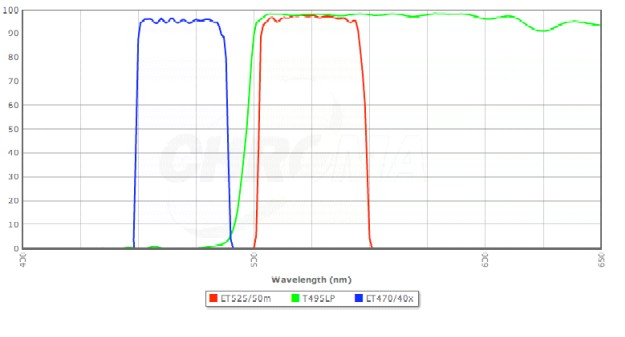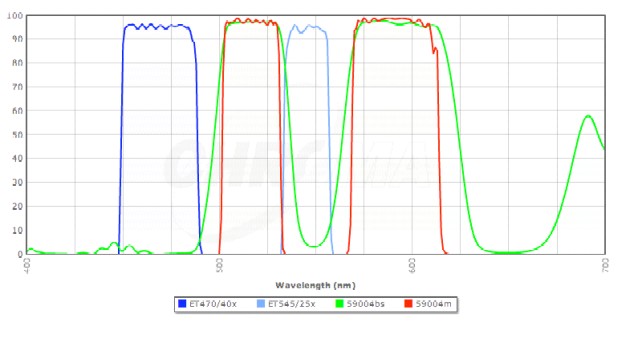www.fluorescencemicroscopy.it
Main menu:
- Home Page
- Microscopes
- Fluorescence
- Description
- Diascopy
- Epi-Fluoresc.
- Illumination
- Installing and Aligning a Mercury Lamp
- Fluorocromes
- Tables of Fluorocromes
- The Fading
- Wavelengths
- Properties
- % of transmission
- Types of filters
- Overlapping Spectra
- Intensity
- Image acquisition
- The Filter's set
- The Filters
- Fluorochrome's praparation
- Sample's preparations
- Fluorescence Sample
- Cytochemical Fluorescence
- Intrinsic Fluorescence
- Gallery
- Phase Contrast
- Polarization
- Darkfield
- DIC
- COL
- Rheinberg
- Brightfield
Overlapping Spectra
Fluorescence
MULTIPLE FLUORESCENT DYES
AND OVERLAPPING SPECTRA
When a sample is investigated with more than one fluorescent probe, there will exist a high probability of overlapping emission spectra. That is, fluorescence of one dye can pass through the emission filter of the other dye. A common example is the overlap of emission of two common dyes Fluorescein and Texas Red (Figure 5).

Figure 5. Overlapping emission “tails” from Fluorescein (A) and Texas Red (B) requires the use of separate selective emission filters.
LONG PASS EMISSION FILTERS
A “standard” Fluorescein filter set includes a “Long Pass” filter as the emission (or barrier) filter (Figure 6). This filter passes fluorescence from Fluorescein, but would also pass the red fluorescence from Texas Red. The resulting “bleedthrough” could confuse interpretation.

Figure 6 Basic Rhodamine filter set (Chroma Corp). The emission filter (A) is a long pass filter that passes all wavelengths longer than 590 nm.
BAND PASS EMISSION FILTERS
A more appropriate filter for visualizing Fluorescein is one that has a Band Pass emission filter in place of the LP shown in Figure 6. Figure 7 shows the spectra of a more discriminating filter set for Fluorescein. The band pass emission filter passes the green fluorescence of luorescein, but blocks longer wavelength emission from other (red) fluorescing dyes such as Texas Red, or from autofluorescence.

Figure 7. Fluorescein/GFP filter set with a Band Pass emission filter. The emission filter passes a discrete window of wavelengths (A).
MULTIPLE WAVELENGTH FILTER SETS
Aside from wavelength overlap and the resulting bleed through, visualizing multiple fluorescent probes introduces another problem. Each filter set consists of three individual glass components, and six refractive surfaces. Samples visualized through a filter set, therefore, produce a refracted image that is almost always offset relative to an image of the same sample but through a different filter cube. It is nearly impossible, therefore, to maintain image registration when merging digital images or making multiple film exposures of a sample when using two or more filter cubes. Interpretation of colocalized fluorescent probes is equivocal at best under these experimental conditions.
A simple solution to the registration problem is through the use of multiple wavelength filter sets. These sets consist of the standard three pieces of glass. However, instead of passing one wavelength slice, these sets pass two or more (Figure 8). Since each probe’s fluorescence passes through thesame glass, registration is maintained between signals, and probe colocalization can be interpreted correctly.

Figure 8. Multiple wavelength filter set for Fluorescein and Rhodamine. Two excitation peaks excite
fluorescein and rhodamine. Two emission peaks pass fluorescence from these two families of dyes.
Sub-Menu:
- Description
- Diascopy
- Epi-Fluoresc.
- Illumination
- Installing and Aligning a Mercury Lamp
- Fluorocromes
- Tables of Fluorocromes
- The Fading
- Wavelengths
- Properties
- % of transmission
- Types of filters
- Overlapping Spectra ←
- Intensity
- Image acquisition
- The Filter's set
- The Filters
- Fluorochrome's praparation
- Sample's preparations
- Fluorescence Sample
- Cytochemical Fluorescence
- Intrinsic Fluorescence
- Gallery